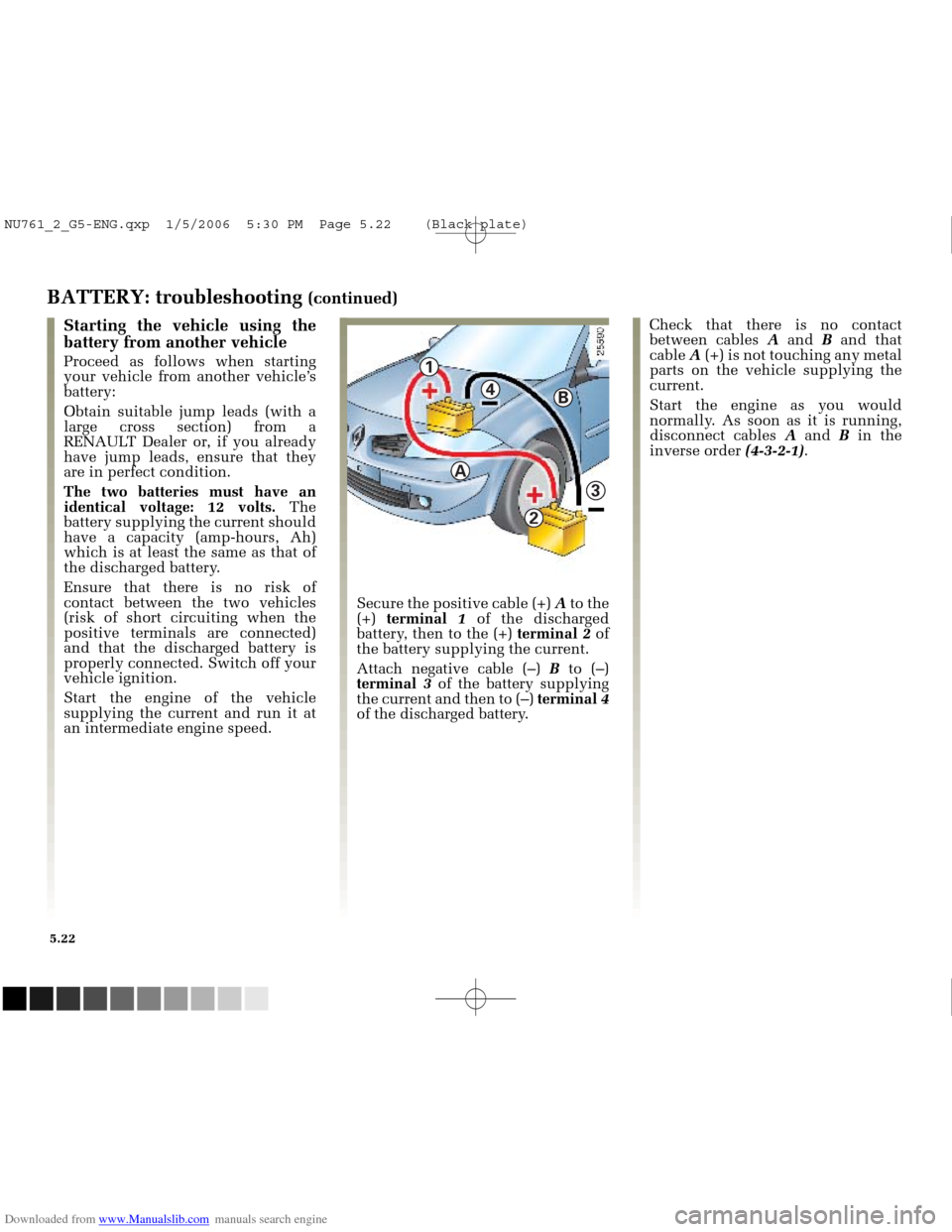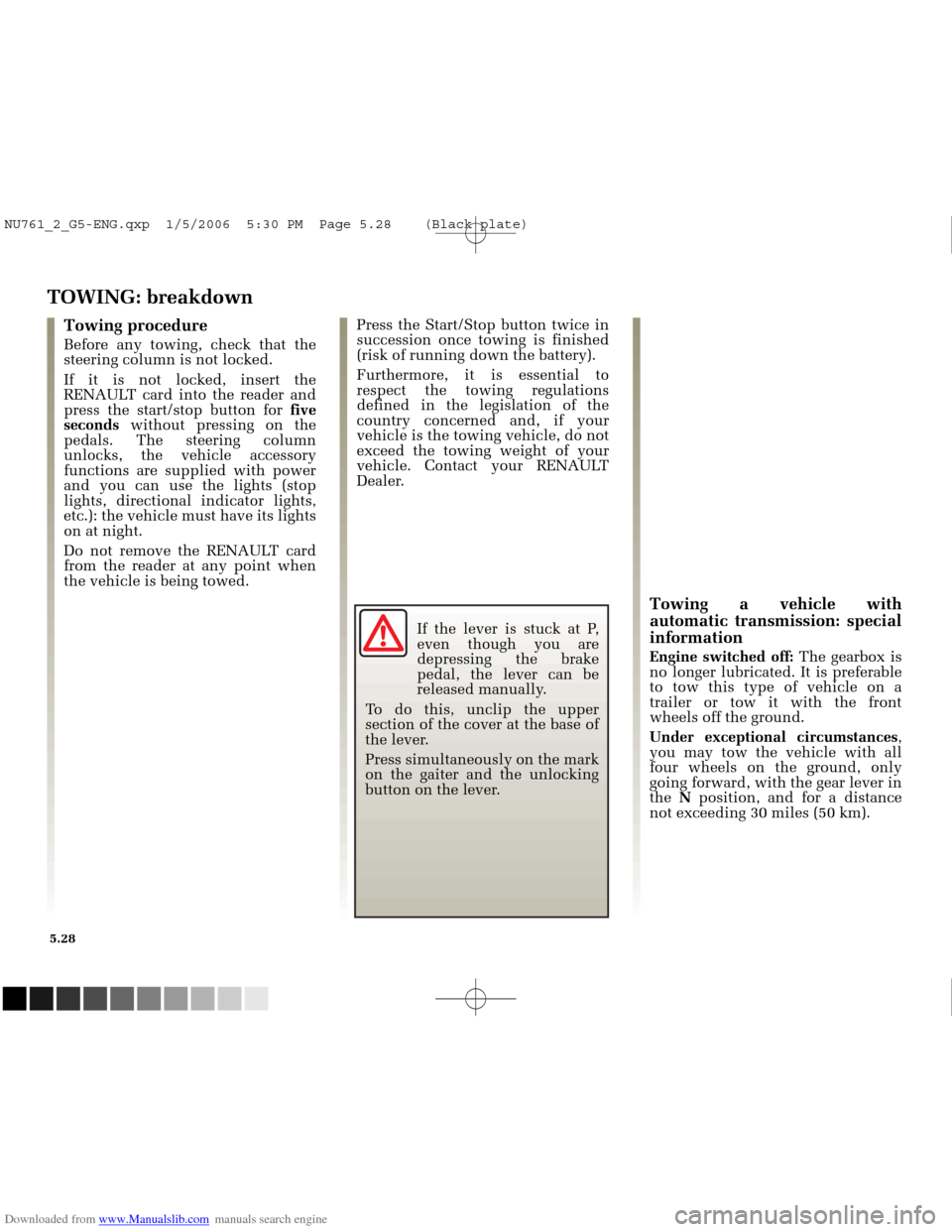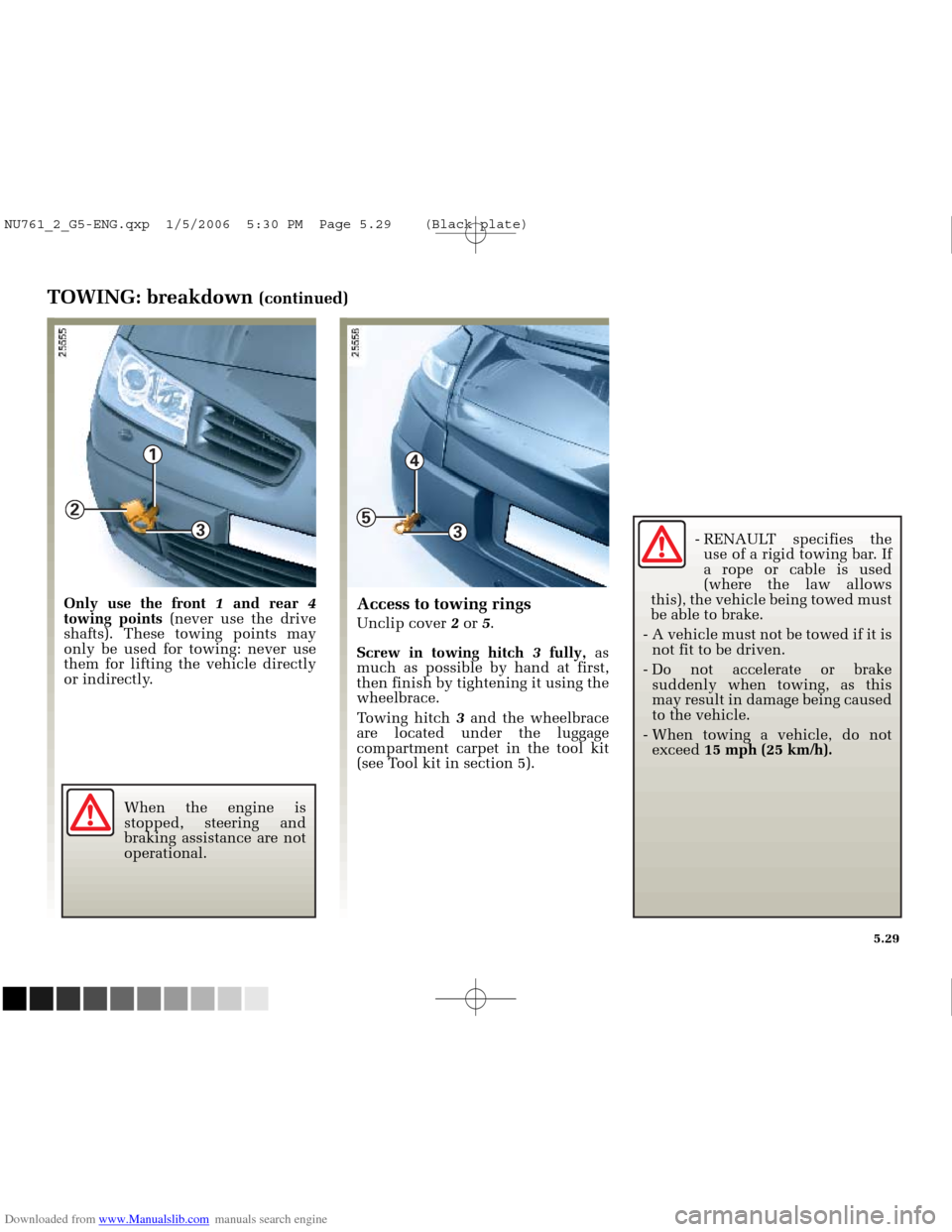Page 190 of 250

Downloaded from www.Manualslib.com manuals search engine
1
4
3
2
NU761_2_G5-FRA.qxd 4/11/05 11:09 Page 5.02
5.02
EMERGENCY SPARE WHEEL
Emergency spare wheel 3
This is located in the luggage
compartment.
To access it:
- open the luggage compartment;
- lift the carpet 1and 2(depending
on vehicle);
Special note:
The “Tyre pressure monitor”
function does not monitor the
emergency spare wheel (the wheel
replaced by the emergency spare
wheel disappears from the
instrument panel display).
Refer to the Tyre pressure monitor
information in Section 2.
- unscrew the centre fixing 4.
- remove the emergency spare wheel.
If the spare wheel has
been stored for several
years, have it checked by
your Dealer to ensure that
it is still safe to use. Vehicles fitted with an
emergency spare wheel
smaller than the four
other wheels.
When using the emergency spare
wheel, driving speed should not
exceed 78 mph (130 km/h).
Replace the emergency spare
wheel as soon as possible with a
wheel with the same dimensions
as the original.
NU761_2_G5-ENG.qxp 1/5/2006 5:30 PM Page 5.02 (Black plate)
Page 191 of 250
Downloaded from www.Manualslib.com manuals search engine
1
3
4
2
5
A
NU761_2_G5-FRA.qxd 4/11/05 11:09 Page 5.03
5.03
TOOL KIT
The tool kit Ais located inside the
luggage compartment to the right of
the emergency spare wheel.
To gain access to the tools, remove
the emergency spare wheel then
release the tool kit.
Wheel trim tool 2or 4
This tool is used to remove the
wheel embellishers.
Towing hitch 3
Refer to the information on Towing
in Section 5.
Wheelbrace 5
This is used to tighten or release the
wheel bolts.
Storage compartments
Locations are provided in the tool
kit to store an anti-theft wheel
locking nut.
Jack 1
Remove jack 1.
When replacing the jack, fold it up
completely and replace it in its
location.
The jack is designed for
wheel changing purposes
only. Under no
circumstances should it
be used for carrying out repairs
underneath the vehicle or to gain
access to the underneath of the
vehicle.
NU761_2_G5-ENG.qxp 1/5/2006 5:30 PM Page 5.03 (Black plate)
Page 195 of 250

Downloaded from www.Manualslib.com manuals search engine
NU761_2_G5-FRA.qxd 4/11/05 11:09 Page 5.07
5.07
TYRES (continued)
Pressures should be checked when
the tyres are cold; ignore higher
pressures which may be reached in
hot weather or following a fast
journey.
If the tyre pressures cannot be
checked when the tyres are cold,
assume an increase of 0.2 to 0.3 bar
(or 3 psi. ).
Never deflate a hot tyre.
Note: a label (depending on country
or model) fixed to the edge or frame
of the driver’s door gives the
recommended tyre pressures.
Changing wheels around
This practice is not recommended.
Tyre pressures
Tyre pressures must be adhered to,
tyre pressures for all wheels
(including the spare wheel) must be
checked at least once a month and
always before a long journey (refer
to the information on Tyre
pressures).
Emergency spare wheel
Refer to the information relating to
the emergency spare wheel and
changing a wheel in Section 5.
Fitting new tyres
Incorrect tyre pressures
lead to abnormal tyre
wear and unusually hot
running, factors which
may seriously affect safety and
lead to:
- poor roadholding,
- the risk of blow-outs or of throwing a tread at high speed.
The pressure depends on the load
and the speed of use. Adjust the
pressures according to the
conditions of use (refer to the
information on Tyre pressures). Vehicles equipped with
the tyre pressure monitor
Each of the sensors fitted
in the valves is dedicated
to one particular wheel: the
wheels must therefore not be
swapped around.
There is a risk of incorrect
information which could have
serious consequences. For safety reasons, this
operation must be carried
out by a specialist.
Fitting different tyres may
change your vehicle as follows:
- It may mean that your vehicle no longer conforms to current
regulations.
- It may change the way it handles when cornering.
- It may cause the steering to be heavy.
- It may cause tyre noise.
- It may affect the use of snow chains.
NU761_2_G5-ENG.qxp 1/5/2006 5:30 PM Page 5.07 (Black plate)
Page 210 of 250

Downloaded from www.Manualslib.com manuals search engine
4
1
A
2
3
B
NU761_2_G5-FRA.qxd 4/11/05 11:09 Page 5.22
5.22
BATTERY: troubleshooting (continued)
Starting the vehicle using the
battery from another vehicle
Proceed as follows when starting
your vehicle from another vehicle’s
battery:
Obtain suitable jump leads (with a
large cross section) from a
RENAULT Dealer or, if you already
have jump leads, ensure that they
are in perfect condition.
The two batteries must have an
identical voltage: 12 volts. The
battery supplying the current should
have a capacity (amp-hours, Ah)
which is at least the same as that of
the discharged battery.
Ensure that there is no risk of
contact between the two vehicles
(risk of short circuiting when the
positive terminals are connected)
and that the discharged battery is
properly connected. Switch off your
vehicle ignition.
Start the engine of the vehicle
supplying the current and run it at
an intermediate engine speed. Check that there is no contact
between cables
Aand Band that
cable A(+) is not touching any metal
parts on the vehicle supplying the
current.
Start the engine as you would
normally. As soon as it is running,
disconnect cables A and B in the
inverse order (4-3-2-1).
Secure the positive cable (+) Ato the
(+) terminal 1 of the discharged
battery, then to the (+) terminal2 of
the battery supplying the current.
Attach negative cable (–) B to (–)
terminal 3 of the battery supplying
the current and then to (–) terminal4
of the discharged battery.
NU761_2_G5-ENG.qxp 1/5/2006 5:30 PM Page 5.22 (Black plate)
Page 216 of 250

Downloaded from www.Manualslib.com manuals search engine
NU761_2_G5-FRA.qxd 4/11/05 11:10 Page 5.28
5.28
TOWING: breakdown
Press the Start/Stop button twice in
succession once towing is finished
(risk of running down the battery).
Furthermore, it is essential to
respect the towing regulations
defined in the legislation of the
country concerned and, if your
vehicle is the towing vehicle, do not
exceed the towing weight of your
vehicle. Contact your RENAULT
Dealer.Towing procedure
Before any towing, check that the
steering column is not locked.
If it is not locked, insert the
RENAULT card into the reader and
press the start/stop button for five
seconds without pressing on the
pedals. The steering column
unlocks, the vehicle accessory
functions are supplied with power
and you can use the lights (stop
lights, directional indicator lights,
etc.): the vehicle must have its lights
on at night.
Do not remove the RENAULT card
from the reader at any point when
the vehicle is being towed.
Towing a vehicle with
automatic transmission: special
information
Engine switched off: The gearbox is
no longer lubricated. It is preferable
to tow this type of vehicle on a
trailer or tow it with the front
wheels off the ground.
Under exceptional circumstances ,
you may tow the vehicle with all
four wheels on the ground, only
going forward, with the gear lever in
the N position, and for a distance
not exceeding 30 miles (50 km).
If the lever is stuck at P,
even though you are
depressing the brake
pedal, the lever can be
released manually.
To do this, unclip the upper
section of the cover at the base of
the lever.
Press simultaneously on the mark
on the gaiter and the unlocking
button on the lever.
NU761_2_G5-ENG.qxp 1/5/2006 5:30 PM Page 5.28 (Black plate)
Page 217 of 250

Downloaded from www.Manualslib.com manuals search engine
3
1
2
3
4
5
NU761_2_G5-FRA.qxd 4/11/05 11:10 Page 5.29
5.29
TOWING: breakdown (continued)
Only use the front 1and rear 4
towing points (never use the drive
shafts). These towing points may
only be used for towing: never use
them for lifting the vehicle directly
or indirectly.Access to towing rings
Unclip cover 2or 5.
Screw in towing hitch 3fully, as
much as possible by hand at first,
then finish by tightening it using the
wheelbrace.
Towing hitch 3and the wheelbrace
are located under the luggage
compartment carpet in the tool kit
(see Tool kit in section 5).
When the engine is
stopped, steering and
braking assistance are not
operational. - RENAULT specifies the
use of a rigid towing bar. If
a rope or cable is used
(where the law allows
this), the vehicle being towed must
be able to brake.
- A vehicle must not be towed if it is not fit to be driven.
- Do not accelerate or brake suddenly when towing, as this
may result in damage being caused
to the vehicle.
- When towing a vehicle, do not exceed 15 mph (25 km/h).
NU761_2_G5-ENG.qxp 1/5/2006 5:30 PM Page 5.29 (Black plate)
Page 218 of 250
Downloaded from www.Manualslib.com manuals search engine
A
NU761_2_G5-FRA.qxd 4/11/05 11:10 Page 5.30
5.30
TOWING (attachments)
Permissible nose weight, maximum
permissible towing weight, braked
and unbraked:refer to the
information on Weights in Section 6.
Refer to the manufacturer’s
instructions for information on
how to fit and use the roof rack bar.
Please keep these instructions with
the rest of the vehicle
documentation.
A : 817 mm
NU761_2_G5-ENG.qxp 1/5/2006 5:30 PM Page 5.30 (Black plate)
Page 219 of 250
Downloaded from www.Manualslib.com manuals search engine
NU761_2_G5-FRA.qxd 4/11/05 11:10 Page 5.31
OPERATING FAULTSThe following advice will enable you to carry out quick, temporary repai\
rs. For safety reasons you should always contact
a RENAULT Dealer as soon as possible.
Using the RENAULT card CAUSES REMEDIAL ACTION
The RENAULT card does not unlockand lock the doors. Vehicle located in a high
electromagnetic radiation zone.
Discharged battery. Use the emergency key (refer to the
Emergency key information in
Section 1).
Use of equipment operating on the
same frequency as the card (mobile
phones, etc.). Stop using the equipment or use the
emergency key (refer to the Emergency
key information in Section 1).
Card battery is flat. Replace the battery.
5.31
NU761_2_G5-ENG.qxp 1/5/2006 5:30 PM Page 5.31 (Black plate)